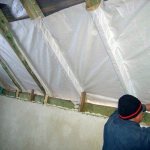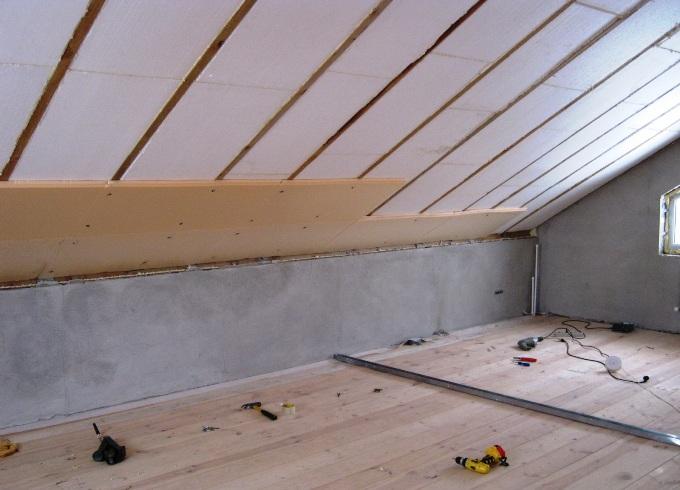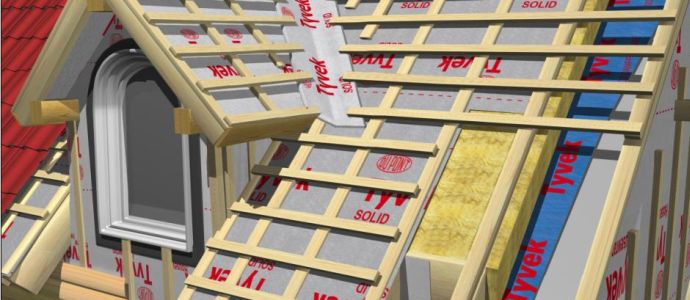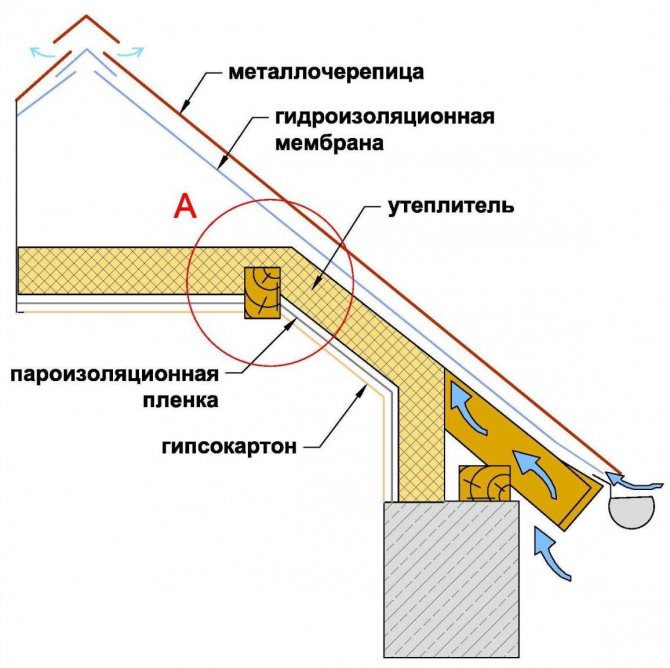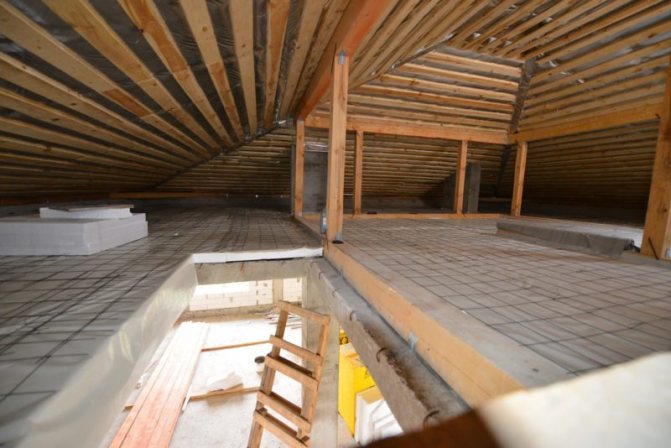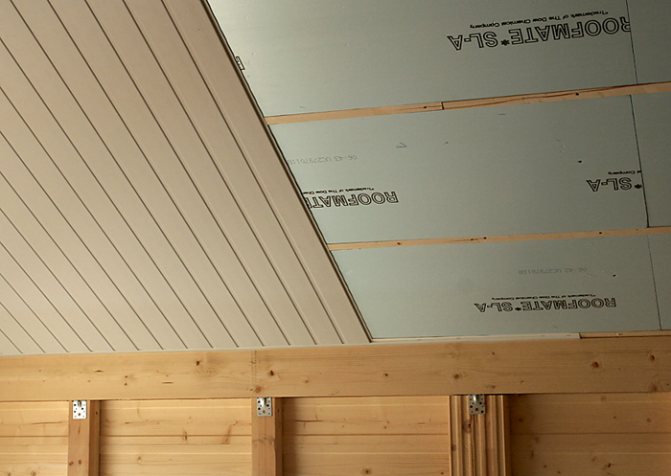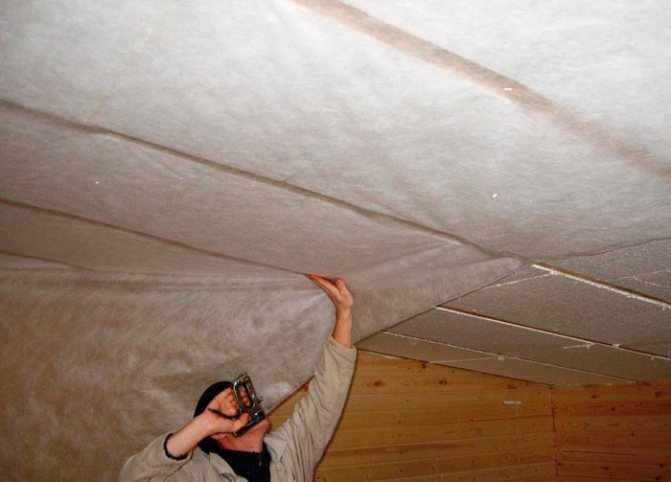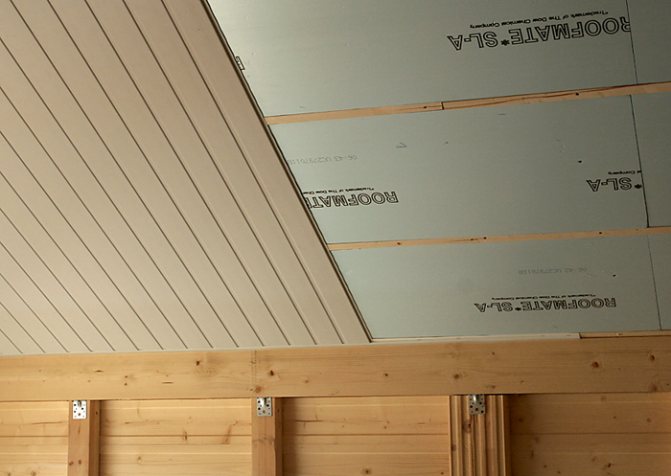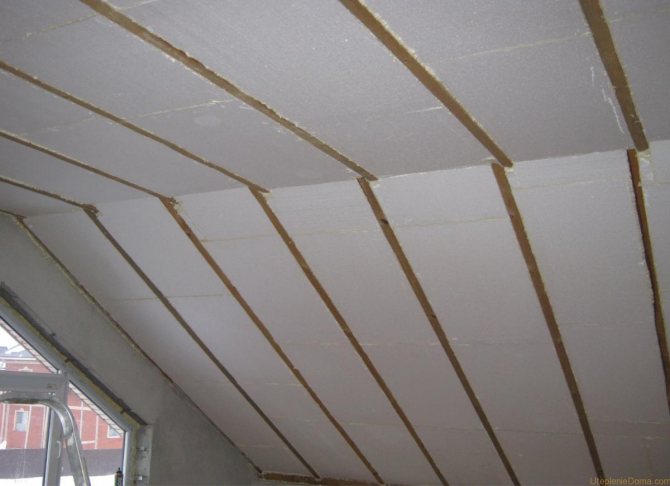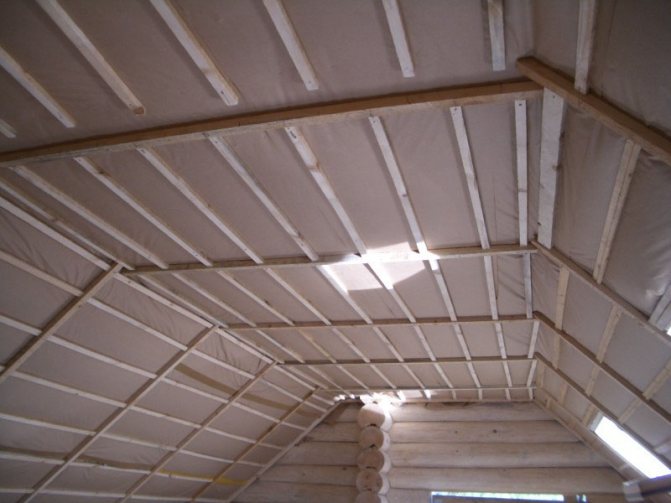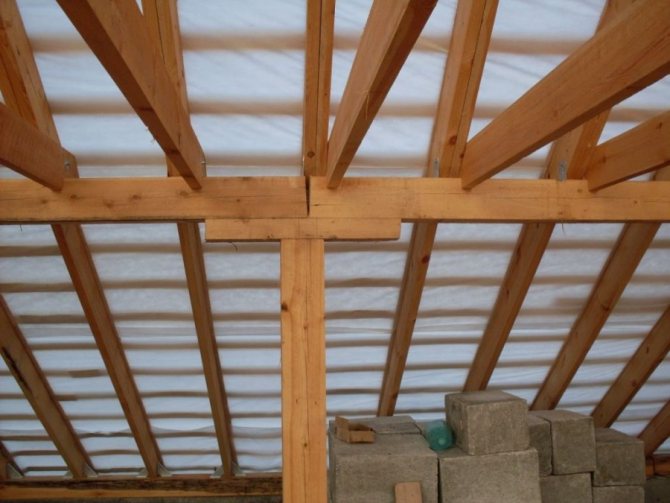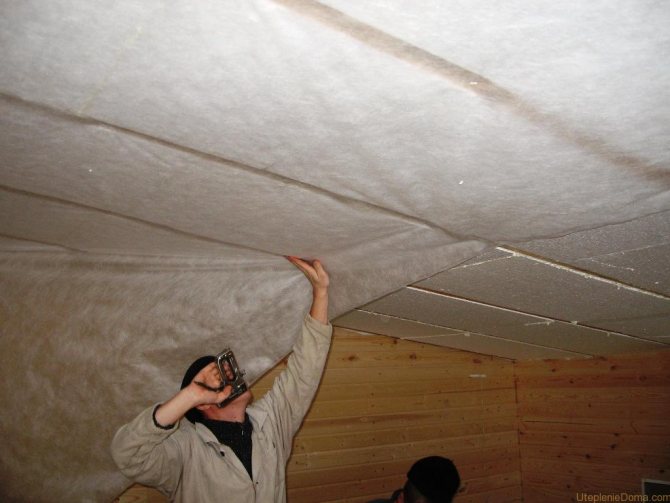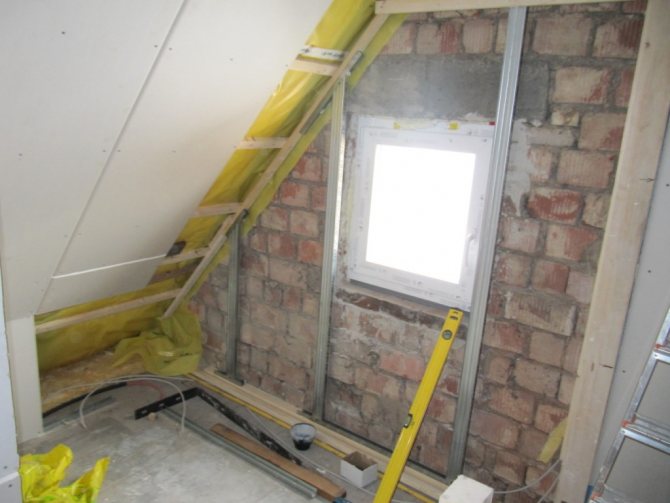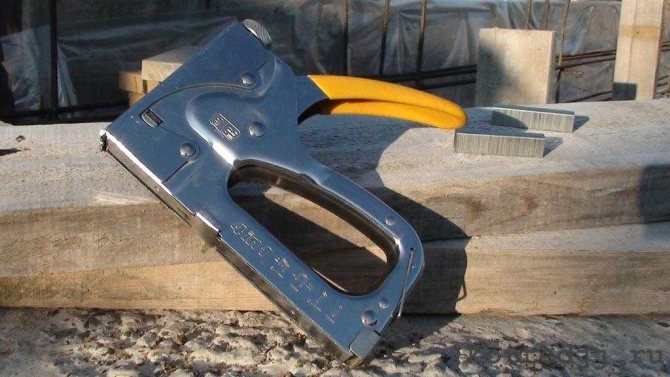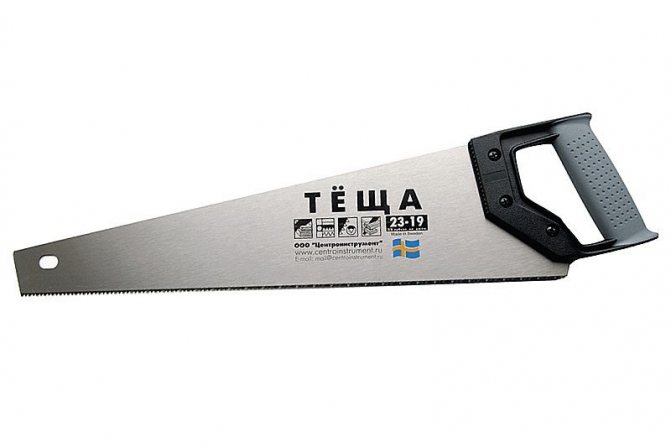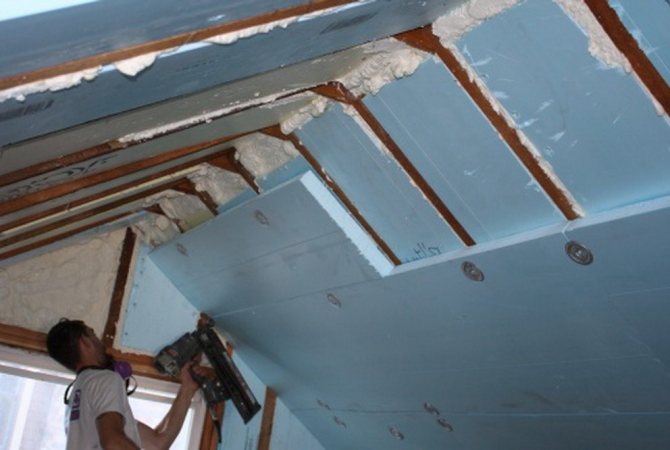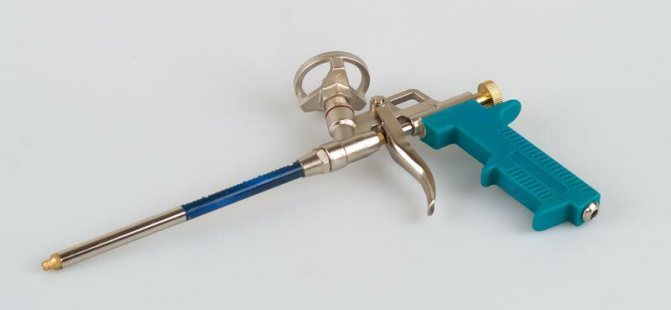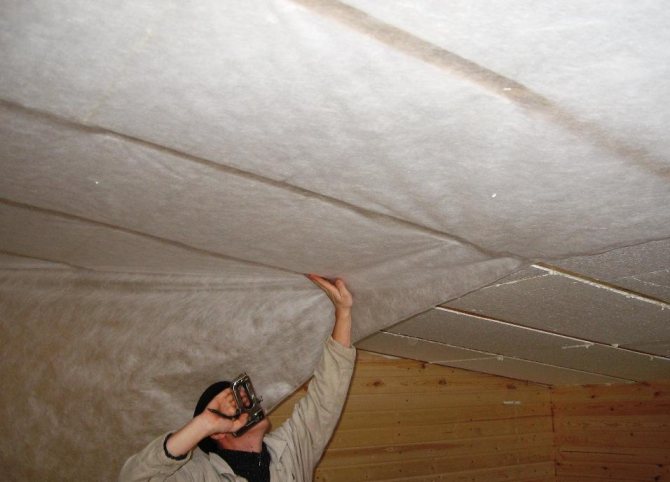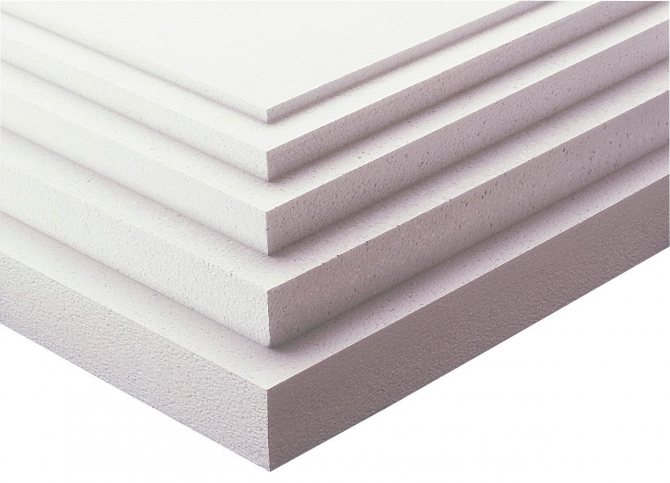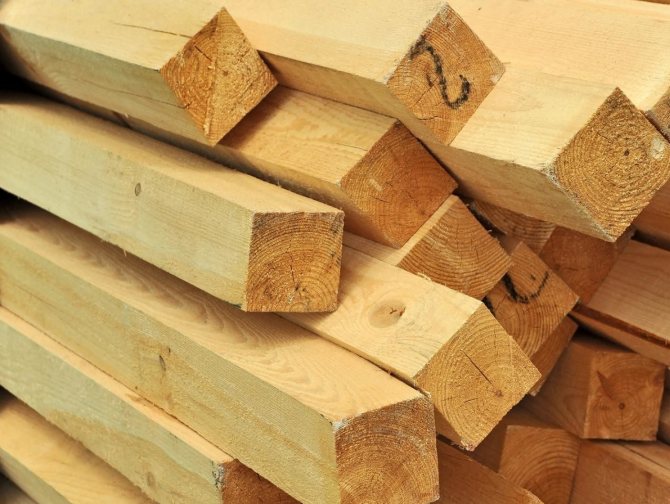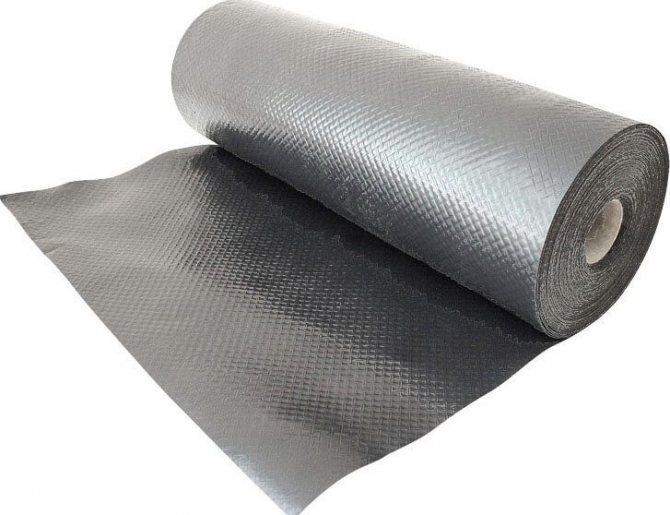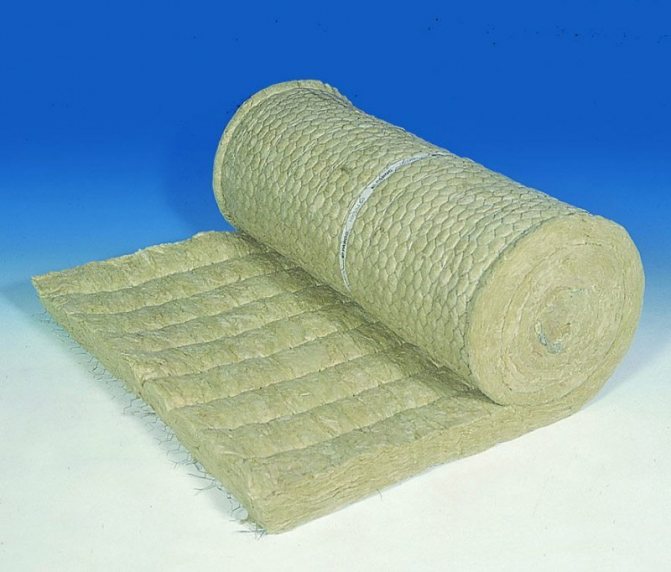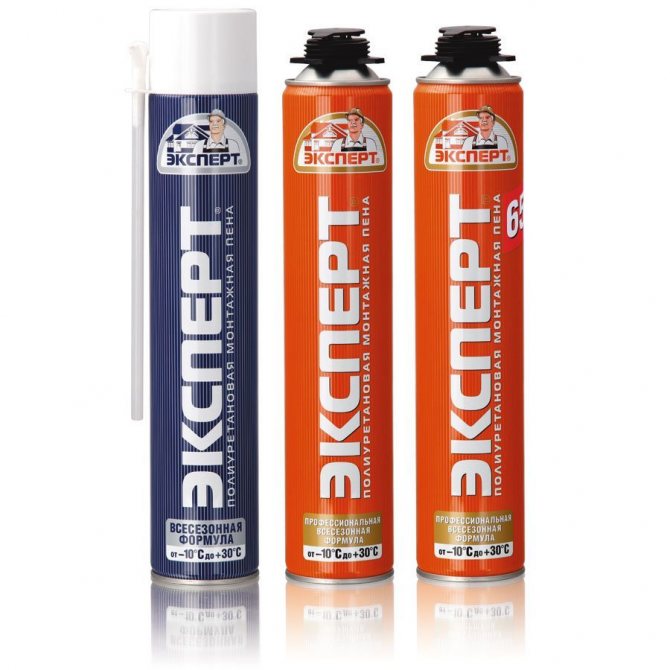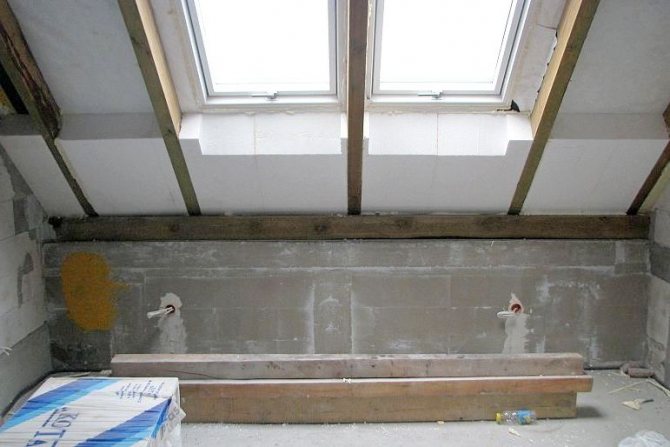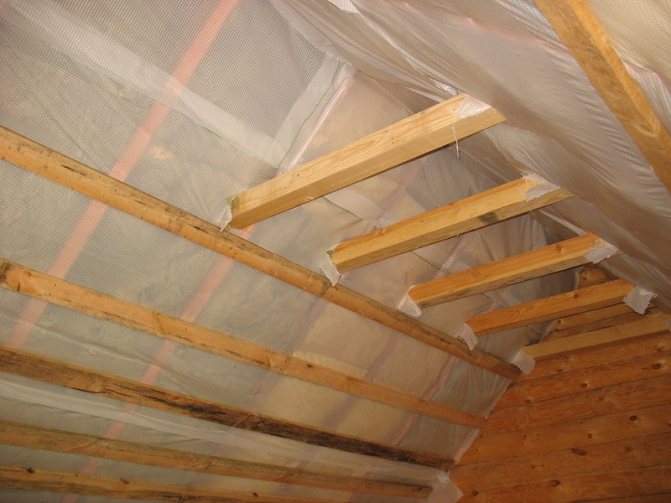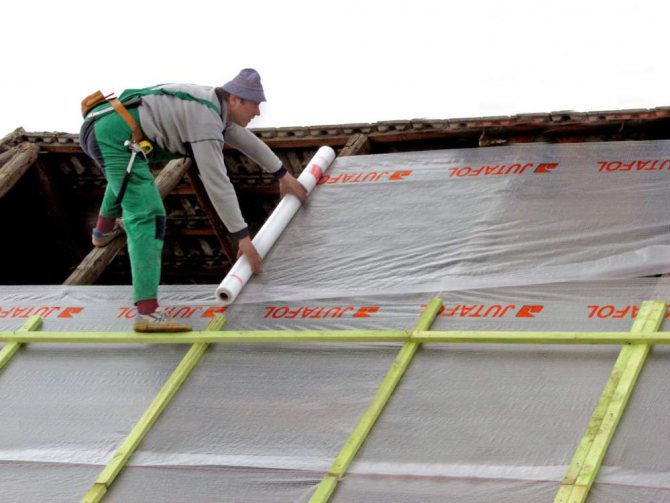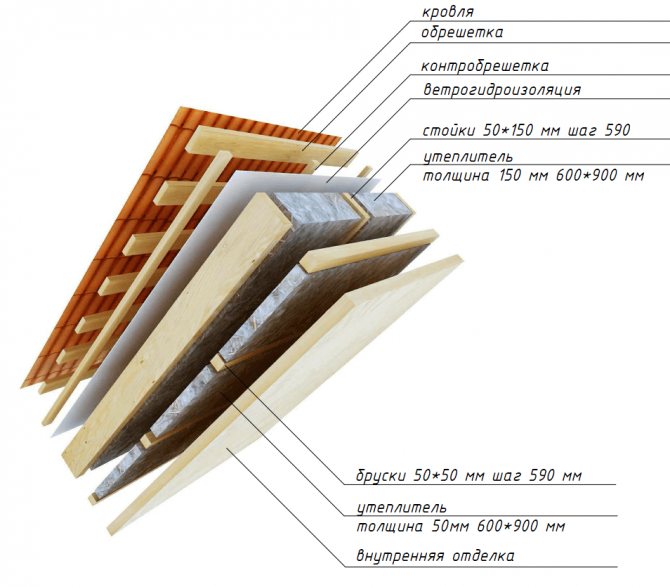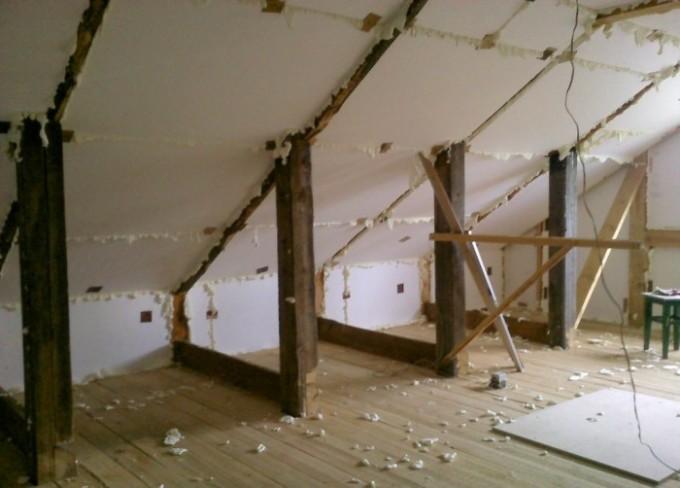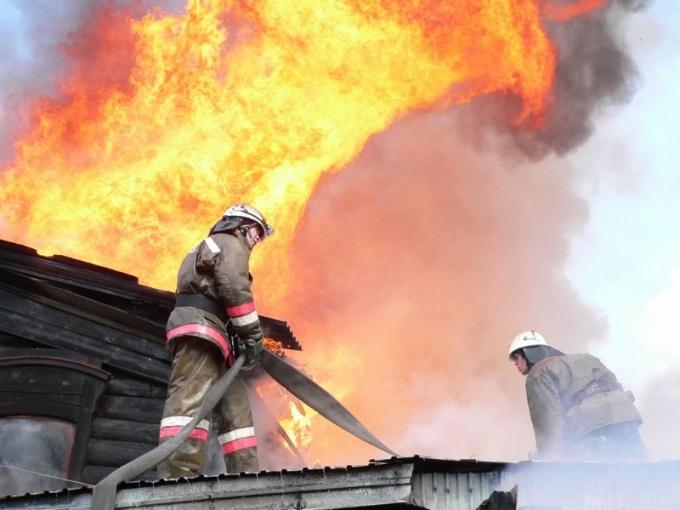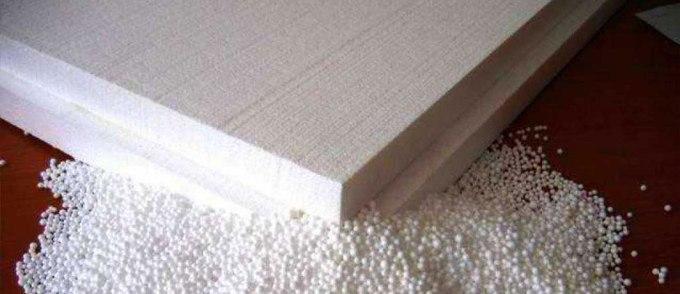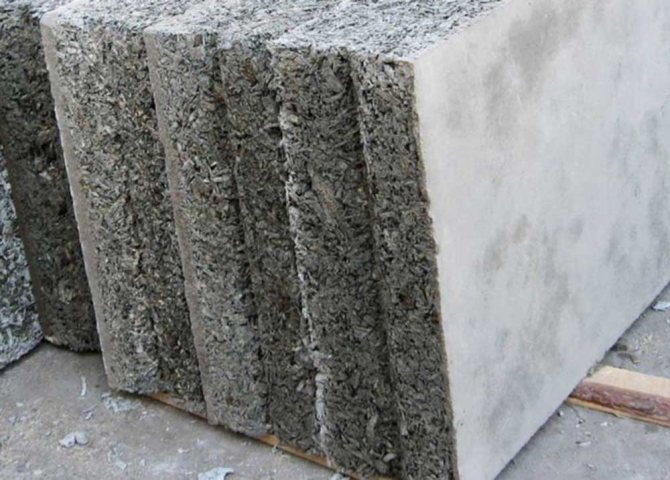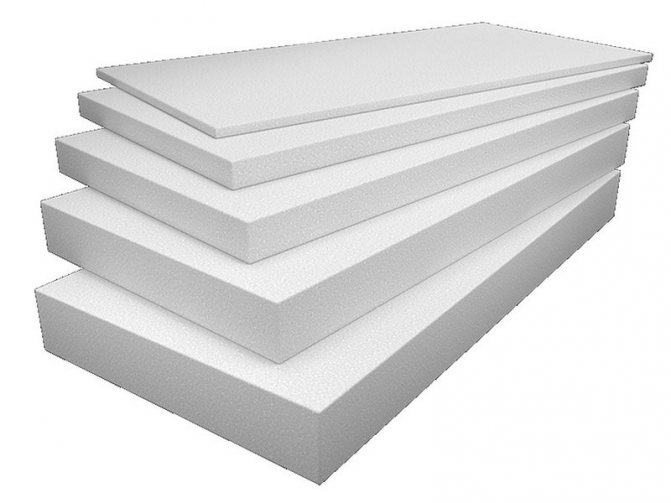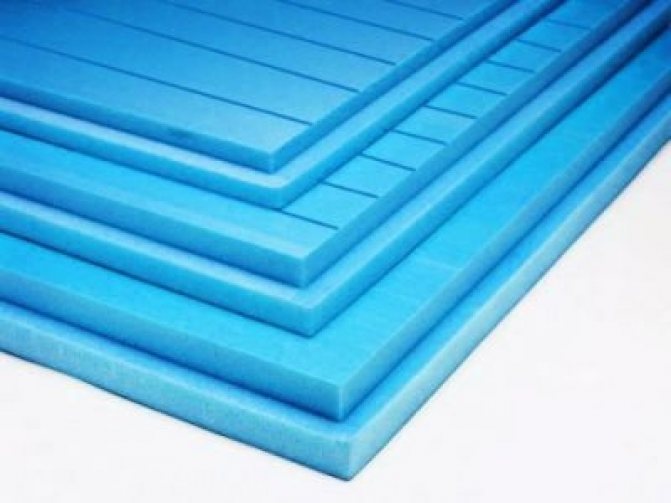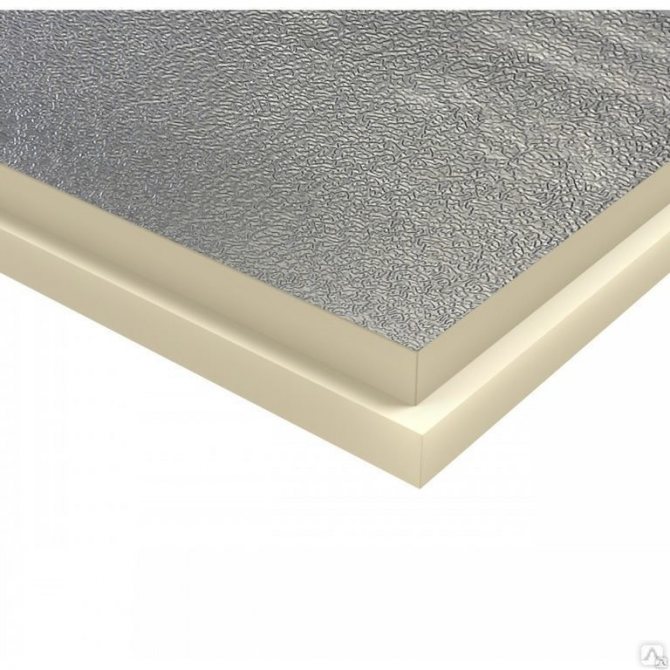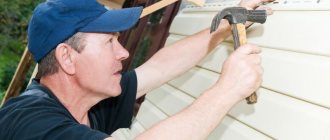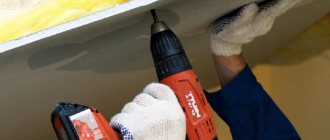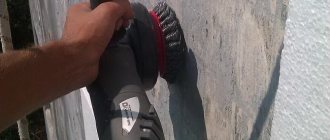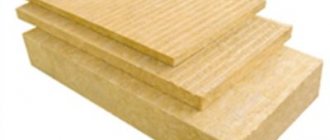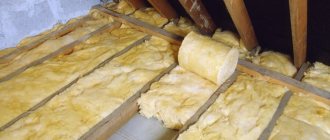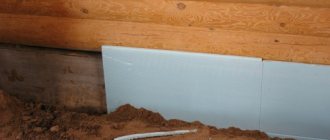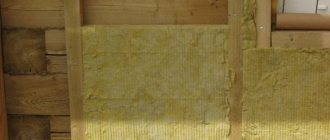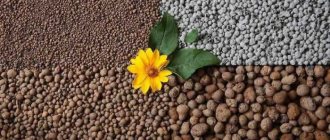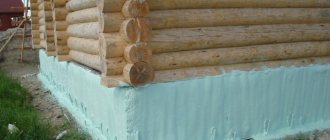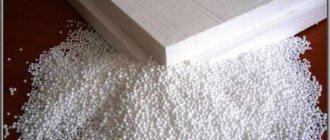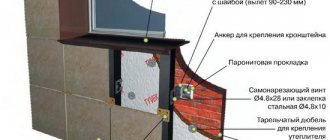Installation of a waterproofing barrier
To eliminate the risk of moisture condensation on the inside of rafters and wall structures when using foam, the first step is to install a waterproofing barrier
... Roll material (film or membrane) must be laid in such a way that it envelops the rafters, adjoins the back of the batten. You can fix it with brackets using a construction stapler, but it is also allowed to use double-sided tape.
The waterproofing layer should be a single piece without seams. If you have to join pieces of film or membrane, you need to overlap at least 15 cm wide and carefully glue the joints with reinforced tape.
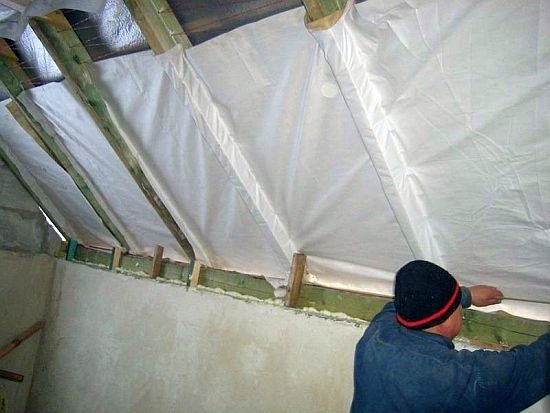
Installation of a waterproofing barrier
If the end walls of the attic (gables) are made of timber or building blocks, you must choose one of two installation options
:
- the waterproofing film is attached with double-sided tape to the flat surface of the wall, after which the sheet heat insulator will need to be fixed with nails with umbrella hats;
- a crate of bars is mounted on the walls, the width of which is equal to the thickness of the selected insulation, a waterproofing barrier is attached on top of them according to the same principle as on top of the rafters.
In the case when expanded polystyrene is chosen as a heat insulator, there is no special need for waterproofing - the insulation will not let moisture from the room to the wooden structures, if you take care of the tightness of the seams when laying the insulation.
How to insulate an attic - a step by step scheme
Step 1: lathing
On the rafters, it is necessary to fill the crate - parallel slats with a step of 50-60 cm, under the width of the insulation. At the same time, make sure that the rafters do not sag and that the crate is even. If you notice unevenness due to the subsidence of the rafters, remove the extra centimeters with a plane, checking the evenness with a building level. This will make it easier for you to install siding or drywall afterwards.
Step 2: Prepare the room and rafters
When the crate is installed, carry out a comprehensive cleaning of the room from construction debris, dust and dirt. If any elements of the rafters or battens are wet after other work, they must be allowed to dry completely or dried with a construction hairdryer. When all the elements are dry and clean, apply an antifungal primer on them, which will subsequently protect the wood from rot and mold, even if the insulation gets wet.
It is best to use a regular brush to apply the protection product - this way the consumption will be less, and the product will penetrate deeper, and the treatment will be much more thorough. The product must be applied in several layers, so that the previous layer dries completely - this can take several days. There is no need to rush!
Step 3: Installation of insulation
Insulation of rectangular sections will not be difficult and will not take much time - I separated the desired piece and inserted the battens between the battens. But you will have to tinker with the corners, because all joints must be tight and not let a single stream of cold air pass through. And the point here is not only in the insulation of the room, if you allow such negligence, cold air will penetrate through the cracks, which, mixing with warm air, will lead to the accumulation of condensate in the insulation itself! The material should be cut with a knife or scissors, be sure to three centimeters more than necessary so that the joint is tighter. Laying mineral wool and foam will take much less time than working with glass wool.
Step 4: layers of vapor and waterproofing
After completing the installation of the insulation, it is necessary to fill or stick layers of hydro and vapor barrier on the crate. Modern materials make it possible to combine both of these properties in one type of coating, however, they also cost an order of magnitude more expensive. It's a matter of taste - either spend extra money on the purchase of expensive material, or spend extra time on installation work. At the joints of the insulation, an overlap of at least 10 cm should be made, nailing it with staples or gluing it with construction tape.
Thermal insulation scheme for the roof of the attic from the inside
Insulation of the attic roof has its own characteristics, due to the fact that the walls of the dwelling are directly adjacent to the roof, more precisely, they actually form a single whole with it
That is why it is customary to pay close attention to the insulation of the attic roof from the inside, which allows you to ensure a normal microclimate in the room.
Before starting a conversation about how to insulate the attic roof from the inside, let's figure out what layers the so-called "roofing pie" consists of, and why it is so important to arrange these layers in the right sequence:
- Roof;
- Waterproofing;
- Ventilation;
- Thermal insulation;
- Vapor barrier.
The diagram shows the correct order of arrangement of the elements of the thermal insulation system of the attic roof
What is the reason for this arrangement of layers? Elementary laws of physics. Let's imagine that a decent layer of snow fell in winter, which, by the way, is a natural heat insulator. As a result of the vital activity of people living in an attic house, warm air will rise from the inside to the surface of the roof. The snow covering it will melt. And as soon as the outside temperature drops below zero, a crust of ice forms, which no longer possesses any heat-insulating properties. The essence of proper insulation of the attic roof is to prevent snow from melting in winter and the penetration of scorching heat in summer.
A few rules to know
The insulation from the inside of the room should have a vapor barrier layer, and from the outside it should be covered with a waterproofing layer. There must be enough free space between the insulation and the roofing material. It is necessary not only for ventilation, but also for the removal of moisture penetrating from the inside of the room with warm air.
The roof of the attic protects the house from precipitation and prevents cooling of the rest of the premises. The loss of warm air through the roof is always significantly higher than through the walls. This is due to the significant difference in air temperatures between the surfaces of the roof.
As you know, the air under the ceiling is always slightly warmer than below. And as a result of this, condensation will form on the ceiling. Therefore, the requirements for roof insulation are always more stringent than for walls.
In an effort to reduce the load on the roof rafters, sometimes lightweight insulation is used, which has a lower density. As a result of the impact of the wind on it, a low density insulation is “blown through” and this leads to a significant loss of heat. To prevent this from happening, an additional windproof layer of vapor-permeable material is applied to the thermal insulation.
Attic roof requirements
The enclosing structure of the attic is the supporting roof system.
Such a system withstands constant and variable loads well, but its elements have no thermal insulation properties, such as those of load-bearing walls, at all.
Therefore, a number of requirements are imposed on the attic roof:
- The final roof covering must have a minimum weight, so that the minimum load on the rafter system. Natural tiles and other heavy-weight roofing materials are inappropriate on the attic roof;
- the insulation of the attic roof should be as effective as possible, this is the only way to make the number of layers of the roofing cake to a minimum. This means that the load on the rafters will decrease;
- ventilation, organized in the under-roof space, has a great influence on the comfortable atmosphere in the attic. And if even small mistakes are made when creating a ventilation system, then there will be high humidity in the room, the thermal insulation properties of the insulation will decrease, and damage to the elements of the rafter system will begin.
Ventilation, which is arranged above the attic in the roof, should remove moisture from the under-roof space as efficiently as possible and, together with waterproofing, protect the insulation layer from getting wet.
Features of the attic room
The main distinguishing feature of the attic from the attic is the presence of a layer of insulation in the walls and roof, which makes it possible to use it for the constant presence of people. The gables of the building and the slopes of the roof act as the enclosing structures of the room. Depending on the shape of the roof, the configuration of the attic will vary.
The most common option:
- two vertical pediments;
- two roof slopes with fractures (in the upper part, the angle of inclination is shallower, at some distance from the ridge, the overhang angle sharply increases and the overhang drops down).
From a structural point of view, the attic is characterized by a variable ceiling height. In the area of the ridge, it will be maximum. As you move away from him, it will fade away.
Attic insulation with polyurethane foam as an alternative to other materials
If you have spare funds and a desire to have high-quality thermal insulation of the attic with little labor costs, consider such an option as polyurethane foam. In fact, this insulation is strikingly different from foam and mineral wool, if only in that it is not laid with plates or mats, but is applied by spraying. Externally, polyurethane foam resembles polyurethane foam, especially after hardening, but it is completely different from it in its structure, being a type of gas-filled plastics, that is, a relative of expanded polystyrene. Having hardened, polyurethane foam has the density of mineral wool, and in its thermal insulation properties surpasses all other insulation materials, including penoizol. Moreover, this material is also a vapor barrier with high water resistance, that is, there is no need for additional protective layers when using it.
To insulate the attic with polyurethane foam, you only need a special sprayer, thick work clothes with a hood and sleeves, thick gloves and, preferably, a mask. The reason for the need for such equipment is not the harmfulness of the insulation at all, but its remarkable adhesion (sticking to any surfaces). If such foam gets on your hair, which is resistant not only to household chemicals, but also to gasoline, as well as weak acids, there will be no choice but to grab a razor and completely get rid of the scalp. Using the minimum means of protection, you will very quickly cover the entire inner part of the roof between the rafters with a thick layer of insulation (the average speed of work is up to 500 square meters per day). A uniform layer eliminates the formation of bridges for cold and dampness, and also provides high reliability of thermal insulation, which often begins to collapse along the line of joints (if any).
However, even such a wonderful material has disadvantages. First of all, this, of course, is the price, but, given the characteristics of polyurethane foam, this is only an indirect disadvantage. The low level of resistance to esters and concentrated acids can also be attributed to the disadvantages only in part, because hardly anyone will visit the idea of pouring sulfuric acid on the roof.But the low heat resistance of polyurethane foam is a really serious flaw in the properties of the material, because, even with a low level of flammability, it begins to deteriorate already at 80-90 degrees, and at higher temperatures it can ignite. Therefore, it is worth thinking about what exactly you would like to insulate the attic, and how to minimize the shortcomings of a particular material.
Benefits of Styrofoam
Insulation of the attic with polystyrene foam can be carried out both at the construction stage and after its completion, when a temporary and financial opportunity arises. Polyfoam is deservedly popular, having pros and cons, the material is easy to install and inexpensive. Insulation of the attic with foam can be done with your own hands in two to three days, the material can be cut at any angle without difficulty, but it is the affordability that determines the increased demand for it.
Polyfoam has undeniable advantages, these are:
- light weight, low load on the supporting structure of the roof, house;
- convenient dimensions, polystyrene is produced in sheets that are convenient for roof insulation, which are installed in the intervals between beams, rafters;
- has high rates of thermal insulation;
- hygroscopic;
- provides high-quality sound absorption;
- durable;
- always freely available at a low price.
Polyfoam combines all the desired criteria of price and quality, provides good protection for the attic room, the room under the roof is guaranteed against fungal growth and mold. The living room under the roof of the house will delight you with warmth and comfort.
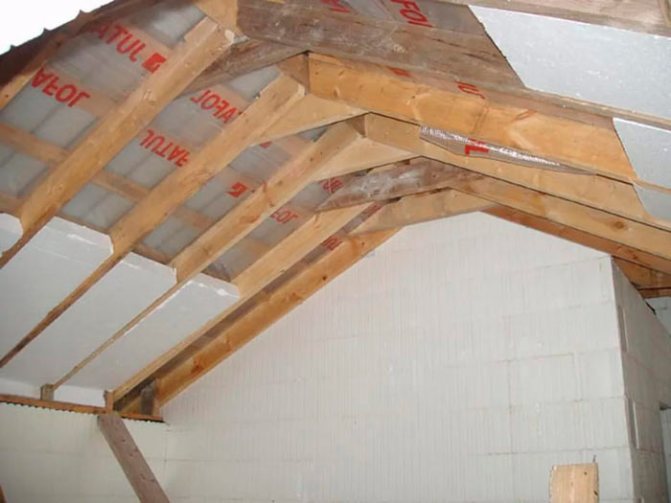

But foam is not an ideal insulation option, as it might seem. There are pros and cons of attic insulation with foam. The disadvantages are also enough to prefer another insulation, in more detail in the material - which insulation to choose for the attic.
The disadvantages of foam include:
- fragility, foam can crumble during cutting, transportation, working with it, especially for low-quality foam;
- the tendency to get wet when directly hit by water, swells in the rain if water gets into the pores and loses the properties of a heater;
- it cannot be painted, it does not tolerate the neighborhood with painted surfaces of the roof, attic;
- upon decomposition, the foam produces a toxic substance styrene, thus, after 10-15 years of operation, the foam requires replacement;
- it collapses under the influence of direct sunlight, but using it under a roof to insulate the attic protects the insulation from such a nuisance.

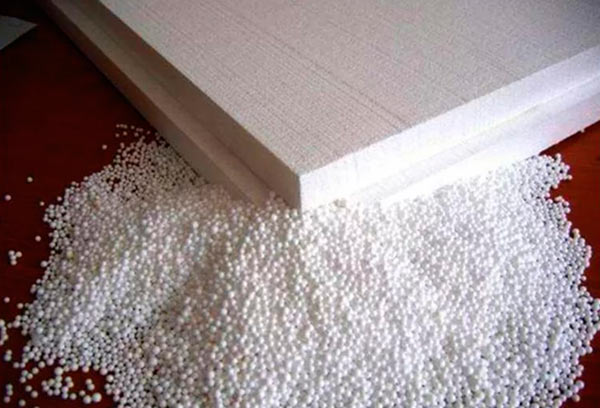
Insulation of the attic with mineral wool
Mineral wool is often used as a material for insulation, due to its properties: it has high thermal conductivity, is not flammable and does not absorb moisture. In addition, insulating an attic with cotton wool is not a difficult process, accessible even to a beginner.
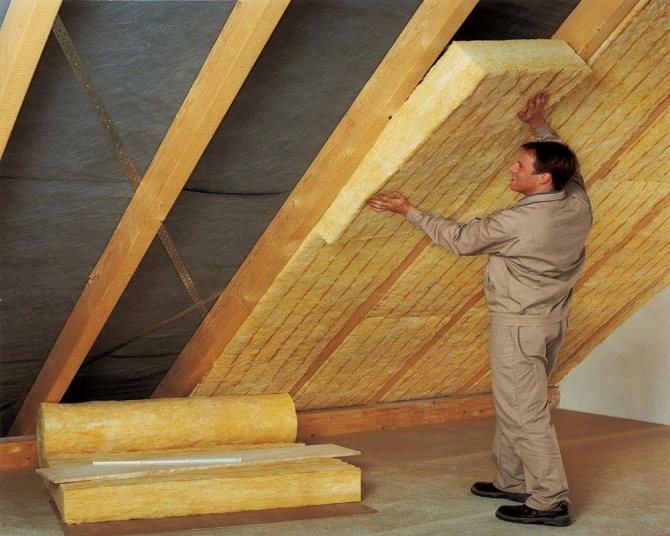

Insulation of the attic from the inside with mineral wool with your own hands
In addition to mineral wool, you can also try to insulate the walls of the attic with a similar glass wool material. Its main characteristics are similar to mineral wool, but it has greater strength and good sound insulation. In addition, it can be used at lower outside temperatures, but it absorbs moisture less well than mineral wool. Therefore, in wet rooms it is better to insulate the attic with mineral wool.
Outcome
Styrofoam is a really good thermal insulation material. It is easy to use and has high performance properties.
Its price is lower compared to similar materials. Such advantages are used by supporters of this method of insulation to argue that they are right. But, its merits do not play a significant role when it comes to warming the attic.
The vapor permeability of the foam can provoke stagnation of moisture on the wooden parts of the truss structure, which will lead to premature destruction of the load-bearing elements and create conditions for the growth of the fungus.
The method of installing foam sheets using polyurethane foam, despite its convenience and efficiency, has a serious flaw - the destruction of the connecting seams under the influence of temperature and moisture changes. And if we consider that the attic must be insulated from the inside, then the requirements for environmental cleanliness and fire safety of the heat-insulating material increase. Polyfoam is unable to meet such requirements, therefore, foam insulation of the attic, although a cheap way, is extremely dangerous.
The process of warming the upper part of the house always remains relevant, however, recently, the use of foam for internal heat preservation of the attic has raised doubts among many people. If you carry out thermal insulation correctly, following all the nuances, you can get a warm and safe room, however, if technology is violated, the material will harm a person. A few recommendations and subtleties of this process will help you avoid difficulties.
Several important recommendations
It is not difficult to properly insulate the roof from the inside, but before starting work, you should pay attention to the following points:
- using mineral wool or slabs as insulation, you need to take care of high-quality waterproofing of the roof;
- if damage was found during the preparation of the roof surface, they must be eliminated. If this is an attic, then it will have to be fully checked for functionality in order to avoid large investments in repairs in the future;
- it will be correct to check the wiring, pipes, heating and water supply risers;
- if the roof is planned to be insulated with mineral wool materials from the inside, then they cannot be squeezed when laying;
- bending the insulating material is also not recommended. In places where it is folded, the material will acquire the ability to absorb moisture.
Feasibility of insulation with expanded polystyrene
What is expanded polystyrene. This is a type of foam that has its pros and cons. The production of expanded polystyrene takes place using polymeric substances, styrenes, which dissolve under the influence of high temperatures and are filled with gas, which increases the volume of the raw materials, fills them with pores.
Polyfoam is used not only in construction, containers for food products are made from it, the material is considered less safe for human health. The thermal conductivity of expanded polystyrene and polystyrene is the same, but the toxicity is higher, so its use in construction is limited by the type of building and location. According to some technical and operational indicators, expanded polystyrene surpasses its counterpart, the coefficient of thermal conductivity is lower, the strength of bending, compression, linear deformation is higher, and the density is higher.
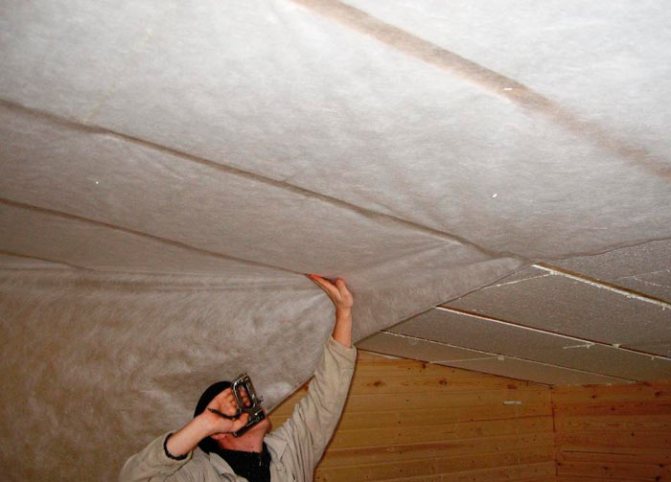

It will not be superfluous to mention another representative of the foam family - penoplex. This is extruded polystyrene foam, a material that is considered environmentally friendly, suitable for use as insulation for residential premises. The advantages of the material are durability, strength. Does not emit toxic gases, does not burn, is inert to acidic environments, aggressive environmental influences. Absolutely hygroscopic, produced by an extrusion method, the material can breathe, which means it creates a beneficial atmosphere for the roofing cake and the entire roof structure. It is more plastic, and contrary to the opinion about the complexity of its use, it is convenient to use even for beginners who have started insulation with their own hands.
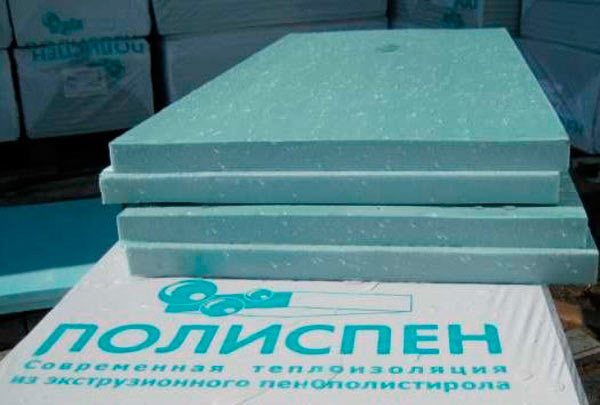

Which of the insulation options to choose is the business of the owner, but obviously, the extruded material has significant advantages over other representatives of the foam family.The use of expanded polystyrene for wooden houses is not recommended. Insulation of the attic with expanded polystyrene is effective only if there is good forced and natural ventilation.
The fragility of thermal insulation properties
This is due to the fact that foam is used to fix the foam, which is used to fill the cracks and fasten the sheets of material together.
This method is convenient, but not durable. After installation, in fact, a sealed layer of thermal insulation is formed, since the foam easily flows into all the cracks and fills in hard-to-reach places. The protective effect of the new thermal insulation is quite high.
But, again, the attic is a special room.
Its design is constantly subject to intense environmental influences. In summer, thermal insulation is exhausted by sudden temperature changes, when the roofing material practically heats up during the day and cools down at night. In winter, snow accumulates on the roof and ice freezes, and in rainy weather the humidity rises significantly.
Such conditions will certainly affect the condition of the joints between the foam sheets, which will dry out. Losing its solidity, the foam insulation ball will become vulnerable, and heat losses will increase several times. As a result, the advantage of polystyrene not to lose its thermal insulation properties is inappropriate for attic rooms, since the main losses will occur through the destruction of the polyurethane foam.
Features of the attic roof insulation with expanded polystyrene
Expanded polystyrene (also called polystyrene foam) is one of the most popular insulation materials used for thermal insulation of attic roofs.
This material actually has quite a few advantages:
- light weight;
- good resistance to compression and stretching;
- low cost;
- high resistance to temperature extremes and various mechanical influences;
- high rates of fire and heat resistance;
- long service life - up to 80 years;
- ease of installation.
And they insulate the roof of the attic with expanded polystyrene in this order:
- all protruding screws and nails should be removed from the wooden elements of the rafter system;
- a layer of waterproofing should be laid on the rafters, which we fasten with a furniture stapler;
- now between the rafters should be laid out sheets of foam. Each sheet should be adjusted so that it fits as tightly as possible, and there are no gaps. To fix the insulation, use glue, wooden slats, or special dowels with wide caps;
- now, to seal the joints between the foam sheets, they should be treated with any high-quality sealant. Or polyurethane foam;
- the next stage is the installation of a vapor barrier layer. For fastening, there is nothing better than a furniture stapler;
- at the final stage, the premises are being finished. For this, drywall, wooden lining, OSB boards are used, which are subsequently painted, pasted over with wallpaper or varnished.
Attic insulation technology with foam
As in absolutely any technique, the insulation work of the attic involves specific stages that must be strictly followed in order to obtain a good result.
Absolutely any insulation work in the attic arises from the calculation of the necessary materials in order to calculate the materials we need, let's start to figure out what specific materials we need when providing thermal insulation of the attic with foam.
- Waterproofing film - fixed on the space between the rafters and on the rafters themselves (roll-type material)
- Insulation material - in our case, foam
- Vapor barrier film
Based on the available information, we take into account how much material is required to completely close the space we need.
After that everything is calculated, you can safely start work on insulating the attic with foam.
First of all, we put a waterproofing layer, this is necessary so that weather precipitation does not fall on the waterproofer and into the room.
That is why the installation work of this layer is a very important task, which must be done extremely carefully - so as not to spoil the waterproofing layer. Then, as the first stage has been passed, we will proceed to the installation of the warmest layer - foam. It is simply placed in the frame between the rafters, having previously sawed off to size
It is simply placed in the frame between the rafters, having previously sawed off to size
Then, as the first stage has been passed, we will proceed to the installation of the warmest layer - foam. It is simply placed in the frame between the rafters, having previously sawed off to size.
But here difficulties can appear, since the attic is usually an angle roof, which is why the builders invented the option of short-term foam fasteners.
A rope is used, which is passed in turn between the rafter beams (zigzag) and clings to the pre-filled small nails, is pulled in parallel. This is made so that you can thread the foam afterwards.
We pulled the threads, carefully push the foam sheets so as not to break. We put the foam, we proceed to the last stage, insulation of the attic with foam - installation of a vapor barrier layer
We put in the foam, we proceed to the last stage, the insulation of the attic with foam - the installation of a vapor barrier layer.
When performing work on thermal insulation of the attic with foam, the following points should be taken into account:
When installing a vapor barrier layer, you need to calculate the ventilation design for air traffic
When performing subsequent work on the interior decoration, experts recommend leaving a distance between the inner lining and the vapor barrier layer of at least 15 cm - this will become part of the ventilation for the interior.
Ventilation is also necessary so that excess moisture is removed, since the foam under the influence of moisture begins to lose its own characteristics, and under the influence of moisture it can have a bad effect on the human condition.
Foam insulation
In order to save money, some people choose foam for insulation.
Experts do not welcome such insulation, claiming that various problems may subsequently arise. Expanded polystyrene has a weak throughput and, in addition to the fact that the room will be poorly ventilated, it is still possible that excess moisture may appear in the roofing "pie" itself. This can lead to mold and mildew.
It is almost impossible to lay the expanded polystyrene plates without gaps, as a result of which the formation of cold bridges is obtained. And the most unpleasant thing is that mice can eat foam plastic, in a short time they can significantly spoil such insulation.
To get into the attic conveniently, you need to take care of the manufacture of the stairs. In the insulated attic, you may need a ventilation system, the device of which is discussed here. It may be interesting for you to read about the interior of the kitchen in a private house at the link https://personalhouse.net/interer/dizayn/interer-kuhni-v-chastnom-dome.
If the roof of the house is insulated completely to the very bottom, then there is no special need to insulate the walls of the attic. But it also happens that the floor of the attic has already been insulated before, then the walls can be additionally insulated. In this case, slats are filled from the back side of the wall every 40 centimeters.
Pre-cut sheets of thermal insulation are laid on them and covered with a vapor barrier material on top. Then, in the same way as when working with the ceiling, everything is hemmed with slats. The joints between the vapor barrier layers are glued with tape to ensure tightness.
Anyone who decides to insulate the attic on their own should remember that the right to choose which materials will be used for this belongs to the homeowner, but it is not worth changing something in the technology, because each deviation can entail undesirable consequences.
Many who begin the construction of a private house prefer the arrangement of the attic floors.The reason for this is the many ready-made attic projects, as well as the desire to add living space to the finished house at the expense of the attic space, but compared to a full-fledged floor, the attic is more prone to heat loss. High heat losses are caused by the fact that mansard rooms have a large area of contact with the street through the roof.
Therefore, in order for the additional floor to become a warm and comfortable room for living, it must be carefully and correctly insulated. At the same time, when choosing a method of insulation, you should not unconditionally accept the advice and recommendations of the builders. It is better to study this issue yourself in order to understand the principles of attic insulation. Then it will be possible to choose the right thermal insulation material and fully control the work of the craftsmen. There are many mistakes in insulation.
A special place is occupied by recommendations to use polymeric materials as insulation, that is, various types of foam. Such advice has so flooded the Internet that many began to consider foam as a suitable material for insulating attics. The many videos captured with detailed instructions look very convincing. But, if you look deeper, it will become obvious that insulation of the attic with foam is dangerous!
How to insulate a residential attic video tutorial and methods of high-quality thermal insulation
As already indicated, there are two methods available for independent implementation:
- from inside the room;
- outside the rafter structure.
The first method is used at the final stage of construction - when the house is ready for use. The second method is applicable in cases where the roof is being installed. It is before this operation that the installation of thermal insulation and all components is performed.
Attic insulation technology from the inside
So, the roof and waterproofing have been installed, all the ventilation and wind protection requirements have been met - you can start working. Beforehand, it doesn't hurt to see how to insulate a residential attic in the video - this will give confidence and theoretical experience. The process is carried out point by point:
- lay the insulation between the rafters, it must fit tightly into the gap between the rafters;
- in the presence of large slopes, the insulation is fixed with a thread that is zigzag stretched between the rafters;
- fasten the vapor barrier.
After that, you can perform cladding work (drywall, wall paneling, MDF).
Thermal insulation installation technology from the outside
This option is performed in conjunction with roofing measures. After the owner of the building has decided what is the best way to insulate a residential attic, you can start the work process:
- fix the vapor barrier on the inside of the room with an overlap of at least 100 mm, the joints should be glued with tape;
- install the inner lathing for cladding - it will additionally fix the membrane;
- lay the mineral wool between the rafters, avoiding gaps and cracks;
- fix the hydro-barrier and counter-rail to provide a ventilated gap;
- install the lathing under the roofing material.
As practice shows, the thickness of the thermal insulation should be in the range of 150-200 mm - this is 2-4 layers of mineral wool. Each subsequent layer should overlap the joints of the previous one to prevent cold bridges.
We insulate a residential attic with our own hands: should we trust the video?
High-quality thermal insulation helps to keep the heating costs of the house to a minimum. A competent choice of material and its installation guarantee an optimal microclimate in the room, and also increases the service life of the elements of the entire structure. There is no doubt that qualified craftsmen will do the job quickly and efficiently, but in this case, you are deprived of moral satisfaction and awareness of your own importance.
If you ask some developers, then many will answer, they say, we insulate the attic with our own hands from the video, which is a dime a dozen on the Internet.And this is the right decision - most of the visual aids consider the entire procedure in detail, advice from experienced specialists is presented.
We also offer an example of useful video material:
Among other things, do not forget about the material component, but it is essential. Thermal insulation installation work is at least 50% of the total cost of the material, and this is a significant amount that can be spent on more useful things.
Insulation of a flat roof
If a decision is made on what kind of insulation to perform thermal insulation, and this is polystyrene, then before carrying out work on laying the material, the surface should be prepared - to clean it from the previous backfill. Then waterproofing is laid on the structure to prevent moisture penetration. The ingress of water on the insulation reduces its operational properties.
After creating a waterproofing layer, foam plates are laid on it.
Particular attention is paid to the tightness of the combined elements, since large gaps and gaps should not be allowed. The service life of the created thermal protection depends on many factors, including how correctly the thickness of the insulation of the attic or roof is selected (read the article: "The thickness of the insulation for the roof and methods of insulation").
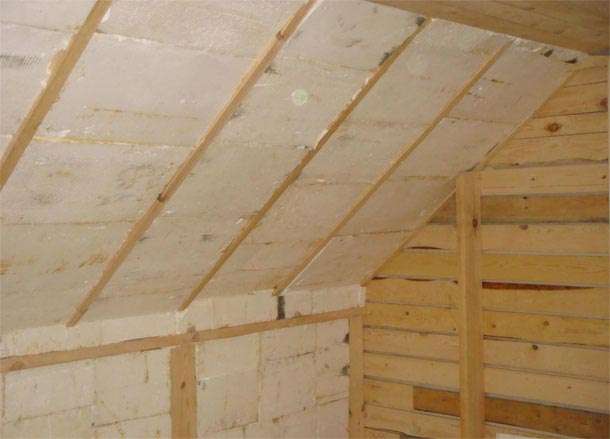

One of the important points is the slope angle of the roof - the minimum slope cannot be made less than 25 degrees, otherwise it is impossible to ensure a normal flow of precipitation from the roof and they will accumulate on its surface. Water should be allowed to flow freely into gutters. In this matter, the main thing is not to overdo it and not make too steep slopes on the roof.
What is required to reduce heat loss
The market of modern building materials can offer the consumer a lot of insulation options. The best materials, more precisely with the most beneficial insulating qualities, will be:
Mineral wool
Time-tested environmentally friendly insulation, endowed with a low coefficient of thermal conductivity. Among its other advantages are: excellent soundproofing and heat-saving qualities.
Styrofoam (expanded polystyrene)
The most commonly used insulator. Its popularity is due to its low cost and easy installation. Available in slabs.
Polyurethane foam
A relatively new material that allows you to reduce the time spent on roof insulation in fact in half. However, its cost is quite high.
All of the above characteristics of quality and versatility are most satisfied with expanded polystyrene of the PSB-S 25 and 35 grades. Its service life is more than 80 years.
Using polystyrene, the easiest way to answer the question is how to properly insulate the roof, spending the minimum amount of time and money.
Advantages and disadvantages
There is still no consensus among experts on whether it is possible to insulate attic roofs with foam.
If we talk about it as a heat-insulating material, then it has many positive aspects. However, roof insulation with foam turns some of its pluses into minuses. Those who advocate foam insulation of the attic argue for the following positive points: Convenience and ease of installation. The material is easy to cut to the required size and can be easily and simply fixed with a mounting tape.
Therefore, often this insulation is laid between the rafter legs and the joints of the plates are glued with tape.
We can say that this is the simplest option for insulation. The main plus for home owners is the reasonable price of the material. In addition, the product does not shrink and has good thermal insulation qualities and good moisture resistance, which is very important for roof insulation. material with a high density, then there will be enough slabs with a thickness of 10 cm. Due to this, you can maintain the useful height of the room. According to some masters, the rafters are cold bridges, so they also need to be covered with heat-insulating material. If we talk about mineral wool and foam, then with the help of the latter, this can be done much easier and faster.
It is enough to lay one layer of material between the rafters, and fix the second on top with overlapping rafter legs.To be completely honest, it is worth noting that some experts, on the contrary, do not recommend insulating the attic with foam: The roof should be insulated with materials that will ensure the dryness of the wood and have sufficient vapor permeability. This is necessary for natural ventilation of the wooden rafter system. Since foam has a low vapor permeability, it will not be able to remove excess moisture from wooden structures, which will quickly lead to their deterioration. Since gaps form between the foam sheets and the wooden structures themselves, they are often sealed with polyurethane foam ... This allows you to fix the insulation well and achieve airtight thermal insulation.
But the trouble is that, due to temperature changes and external influences, the foam seam quickly collapses, as a result, cold bridges form in the joints. Polyfoam not only refers to combustible materials, it also releases toxic compounds during combustion. This is especially dangerous, after all, the material insulates the attic from the inside on large areas. Even if the roof covering is non-combustible, the foam will do its dirty work. Insulation of the attic roof with this heat insulator is undesirable due to harm to human health.
When this material is attached to the walls of the house from the outside, it does not affect the person, but from the inside of the attic, no interior decoration will protect from the styrene released. When exposed to heat, the rate of release of toxins from the foam increases
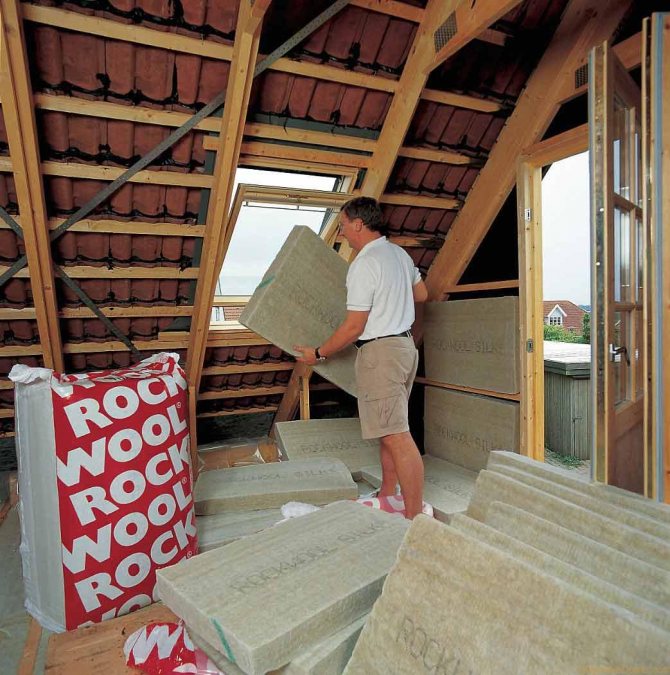

This can be due to the internal heat in the house or the sun-hot roof. As you can see, this material has so many disadvantages that it is much better to insulate the attic with expanded polystyrene. It is considered non-flammable and does not emit harmful compounds. Moreover, expanded polystyrene refers to vapor-permeable products, which is much more beneficial for a wooden roof frame.
Why do builders recommend Styrofoam?
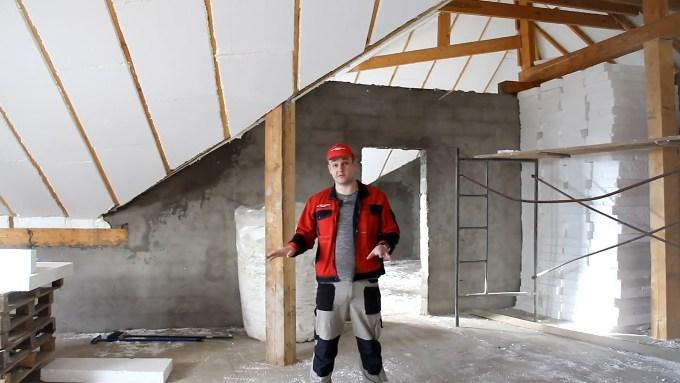

If we consider foam as a heat-insulating material, then it really has wide application and has many advantages. But, in the case of the attic, some of the advantages of foam become disadvantages. Yes, this material is very convenient in work and has a low cost, but it will not provide durable thermal insulation and safety of living. In order not to succumb to persuasion to insulate with foam, you need to know the main arguments of the supporters of this material.
- Ease of installation. Few builders can give this reason, since we are talking about simplifying their work. The fact is that the foam is easy to process, it is simply cut and adjusted to the desired size. Polyurethane foam is used to fix the sheets. Thus, between the roof rafters, sheets of material are laid, which are glued to each other at the joints. This is the fastest way to insulate. This means that the master will receive a decent income in the shortest possible time.
- Material advantages. The main advantage for the owner of the attic is the relatively low price in comparison with other available materials. Other advantages include good thermal insulation properties, the ability to not shrink over time and moisture resistance.
- A small layer of thermal insulation. If you take polystyrene with a high density, then for full-fledged insulation, it is enough to lay sheets 10 cm thick.
- Convenience of overlapping "cold bridges". To exclude the possibility of heat loss in vulnerable areas, which are rafters, thermal insulation must be laid in two layers. The first layer is laid in the same level with the rafters, and the second layer covers the entire plane. To do such manipulations with foam, according to some builders, is safer than with mineral wool.
Apart from such arguments, it is possible that the popularity of foam has increased through commercial interest. Anyone who wants to sell will praise their product. And the foam, no doubt, has something to praise. But, it is important to note that it is not worth insulating the attic with foam. And there are clear and compelling reasons for this.
Related article: Do-it-yourself inspection hatch
Insulation of the attic with mineral wool arguments Pros and Cons
When choosing building materials, many of us prioritize the price, and only secondarily, the characteristics. And the reason for this is not so much the recent crisis as an elementary desire to save money. True, this will not work with mineral wool, it does not apply to budget materials. However, just the characteristics will more than justify everything that will be spent on mineral wool, which is refractory (withstands temperatures up to 1000 degrees), moisture resistant, has a considerable reserve of hardness and, among other things, is an excellent sound insulator. And all this is only in addition to the excellent thermal insulation properties.
Warming the attic with mineral wool is as easy as the work described above with polystyrene foam plates. However, in this case, neglect other insulating layers, such as the superdiffusion membrane, which is located directly on the battens with a transition to the rafters. Already on top of this moisture-proof layer with a small air gap, slabs of basalt mineral wool are laid, which is then covered with a vapor barrier and only then with decorative decorative panels or plasterboard. Minvata can also make internal wall insulation.
However, it should be borne in mind that mineral wool is far from a safe material and it must be chosen carefully, giving preference to well-known manufacturers. The fact is that the slightest violation of norms and standards in the manufacture of mineral wool makes it extremely hazardous to health. Companies that have long established themselves in the Russian market guarantee the quality of their products, but dozens of little-known companies engaged in the production of mineral wool provide such guarantees, for the most part, unfounded.
How to install polystyrene foam in the attic with your own hands
Insulation with expanded polystyrene is a simple technology available to everyone. Light weight allows you to do all the work with your own hands, even without the involvement of assistants. Warming the attic with extruded polystyrene foam is also easy to do with your own hands.
Extruded polystyrene foam does not require additional waterproofing; it can be used to insulate surfaces from the inside and outside. For insulation of the attic under a gable roof, extruded material is the best.
In order for the expanded polystyrene sheets to better lie on the surface of the crate, its step should be made smaller. The plates are fixed with glue plus small screws on the dowels. Before applying the adhesive, the surface must be cleaned and primed. The base of the glue is cement, so it is not worth it, it should be applied too thickly. The foam surface should be putty with a special solution using a reinforcing mesh. After such finishing, the room looks residential and cozy.
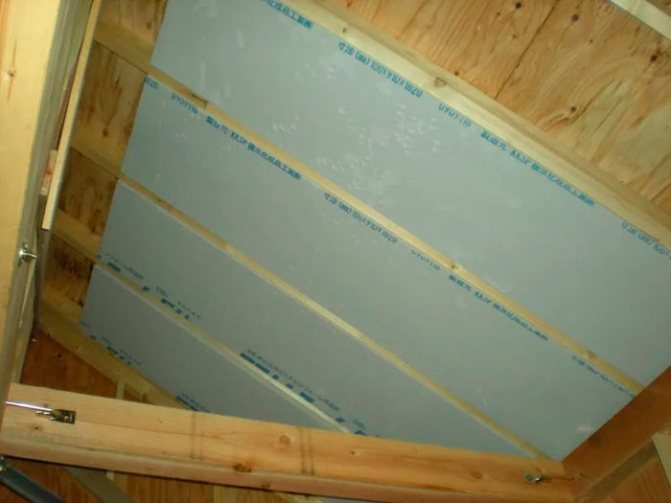

The cladding of the roof from the inside with layers of expanded polystyrene can be made by the above-described method of flooring, by inserting it into the lathing with mechanical fastening similar to that of foam sheets.
Related videos:
Insulation properties
One of the most common and affordable insulation materials is polystyrene foam. It is a gas-filled foamed polymer. Almost the entire volume of material is occupied by air, which is contained in separate closed cells.
Due to their structure, such polymers have a number of properties that make it possible to use them as heat insulating and structural materials:
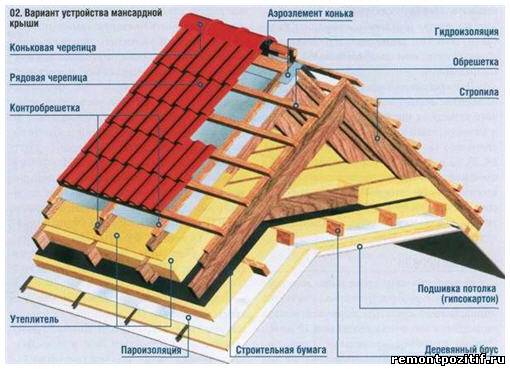

This is how the attic insulation looks like layer by layer
- low value of the thermal conductivity coefficient (0.035 - 0.037 W / (m * K));
- depending on the brand, the density value ranges from 11 to 35 kg / m3;
- the degree of flammability G1 - G4 (for insulation it is better to use low-combustible materials marked G1);
- resistance to biological destruction.
In addition to the listed advantages, attention should be paid to a number of disadvantages that should be taken into account when used in building structures:
- fragility of the material;
- tendency to deteriorate when exposed to direct sunlight;
- instability when exposed to chemical solvents;
- the material has a certain amount of water absorption, which entails the need to use a protective waterproofing layer;
- when heated above 90 - 95 ° C, harmful substances are released into the air of the room.
Pros and cons of insulation of the attic from the inside with foam
Low density foam crumbles and breaks
The choice of foam for attic insulation is often based on the low cost and light weight of the material with strict geometric shapes. However, expanded polystyrene has other advantages:
- The thermal conductivity coefficient is limited to 0.032-0.044 W / m * K, which is lower than some options for mineral insulation.
- The density of the foam has relatively low values, which is important to ensure a minimum load on the support lathing and rafters, supporting structures and the foundation of the building. The low weight of the slabs also simplifies the do-it-yourself installation process, during which there is no need for special lifting equipment.
- Water absorption is 0.2%. This fact does not limit the use of foam in relation to moisture indicators. This means that you can insulate the room, bathroom, walls inside and outside the attic.
- Inertness to biological damage. The synthetic base of expanded polystyrene does not promote or support the development of bacteria, fungus, mold and moss.
- Ease of processing. To insulate the attic from the inside with foam plastic with your own hands, it is enough to have a construction knife, a hacksaw with a small and frequent tooth. Less commonly, an electric jigsaw or a reciprocating saw is used to speed up the process of self-assembly. The slabs are cut effortlessly and quickly.
Important! When choosing a heat-insulating material, it is necessary to consider the coefficient of thermal expansion of the insulation.
The mansard roof has a rafter support system. As a rule, a wooden beam is used to organize the frame. Foam plastic is characterized by a lack of plasticity, which leads to a low risk of cold bridges, excludes mechanical impact on the crate.
Depending on the density of the foam, installation, the service life of the synthetic insulation can be 10-15 years or more, up to 30. Extruded polystyrene foam retains the quality characteristics and physical parameters longer. Also, the material copes better with exposure to ultraviolet radiation, but protection is still required.
Along with the tangible advantages of expanded polystyrene, there are disadvantages that are important to consider before the final choice of one or another insulation:
- Low vapor permeability of foam leads to poor breathability. These facts contribute to the formation of condensation on windows, walls and ceilings, the accumulation of carbon dioxide in the room. It is possible to exclude such consequences only by organizing a ventilation gap in the body of structures, forced or natural ventilation of the inner space of the attic.
- Low resistance to sunlight. Often you have to carry out repairs with your own hands in stages, the insulation is left open for a while. Foam plastic, regardless of composition and density, will begin to change color and crumble in a month.
- The poor resistance of polystyrene foam to solvents must be taken into account during finishing work. Many chemically aggressive substances lead to the destruction of plates almost instantly.
- The low strength of synthetic insulation leads to deformation of the boards under the influence of any type of mechanical load. Under pressure, the density and thermal conductivity change for the worse.
As a result of the contact of polystyrene foam with acetone, the material is destroyed
In addition to negative technical characteristics, the disadvantages include the attractiveness of the heat-insulating material for mice and rats. They easily gnaw through channels for movement and warm burrows for hibernation, nests for reproduction in foam plastic slabs. This significantly increases the heat loss on the mansard roof.
Features and materials for attic insulation
You need to understand that this room, unlike all others, is colder, since it does not have any "heat cushion" on top. Therefore, the insulation, which we will do with our own hands, must be of especially high quality. Based on this, the material is selected.
The difficulty lies in the fact that the surfaces are uneven, since there are rafter beams under the roof, and they will all have to be bypassed. The waterproofing layer will have to be removed under the roof in order to drain the condensate. When organizing work, you need to take into account that the end walls of the attic also need to be covered - it is through them that a large amount of heat escapes. Each house has its own architecture, roof shape and material of roofing and walls.
Therefore, for each dwelling there may be some special, clarifying recommendations for warming the attic space. Therefore, we will dwell only on the basic, mandatory activities that need to be carried out
Each house has its own architecture, roof shape and roof and wall material. Therefore, for each dwelling there may be some special, clarifying recommendations for warming the attic space. Therefore, we will focus only on the main, mandatory activities that need to be carried out.
The choice of material depends on many factors. Roof structure, roofing, local climate and much more. We list only the features of some materials that can be used.
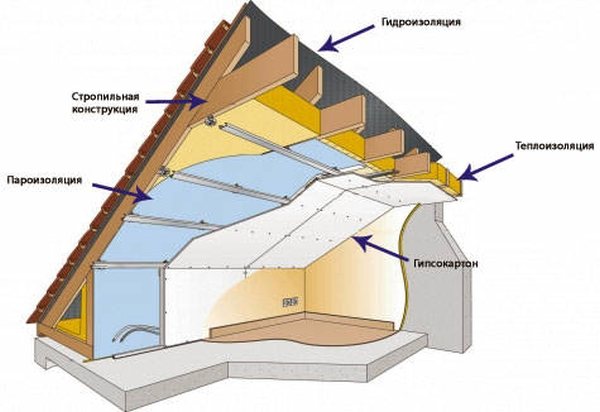

Styrofoam
One of the cheapest, and therefore popular materials for insulation. Easy to process and install. But experts point out that its vapor permeability is small. Consequently, the room may be damp. In addition, as the wooden rafters "dry out", the gaps between them and the foam plates will increase. And these are the slots for drafts. There is one more remark. In such a covering, mice very often equip their homes, and then it will be quite difficult to fight with them.
Mineral wool
Basalt mineral wool is excellent in all respects. Having great strength, it does not absorb moisture, is fireproof and practically does not conduct heat. Since it has elasticity, it adheres well to the installation site, resting its edges against the rafters. Glass wool is more durable and more effective as a sound insulator
It can withstand lower temperatures, but requires special precautions to handle.
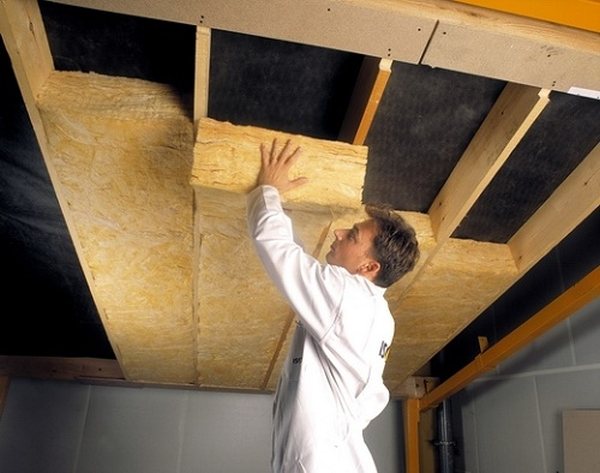

Features of thermal insulation
Heat loss at home.
Insulation of the attic should not allow moisture, as well as heat and cold to enter the upper floor from the street. At the ceiling, the air will always be warmer, since cold air is always at the bottom, moving warm air up. In any scenario, the heat loss from the wall and roof will vary greatly, even if the layers of materials are the same thickness. In addition, due to changes in air temperature in the ceiling area, condensation may appear in the attic, which can spoil the performance of the structure.
The area of the attic ceiling is more susceptible to damage than other elements, for example, a certain temperature change that can cause condensation on the attic ceiling will not affect the walls in any way. Attic rooms are insulated according to much more stringent criteria than the rest of the building. Due to significant heat losses, proper insulation of the attic and walls can greatly reduce the cost of material and additions to it. In addition, modern thermal insulation methods can seriously increase the thermal insulation properties of expanded polystyrene, which can lead to less heating. Unsatisfactory insulation of various parts of the roof can lead to the appearance of large icicles, which, if dropped, can harm a person's physical health. And if you try to knock down the icicles, then the roof can be damaged.
In order to avoid the formation of condensation on the walls and ceiling in the attic, it is necessary to carry out a vapor barrier.
Well-made thermal insulation of the attic will not allow icicles to appear. Insulation is also necessary for the rafter system, otherwise the entire structure will not have the necessary properties and characteristics.
Before carrying out installation work, it should be borne in mind that the amount of moisture in heated air differs greatly compared to cold air, because of this, the release of moisture in the air is carried out into the external environment. Waterproofing material, which is installed in almost all structures, cannot remove moisture to the outside, which can cause all kinds of mold and fungal spores on the walls
The droplets of moisture that can form on the surface of the ceiling are not the result of leaks in the roof, but are only formed due to too much condensation. Therefore, in order to avoid this unfavorable phenomenon, the insulation should be carried out using a layer of vapor barrier material. It is often on top of the base. To remove moisture from the roof elements, an air cushion needs to be made, which will act as a kind of ventilation.

